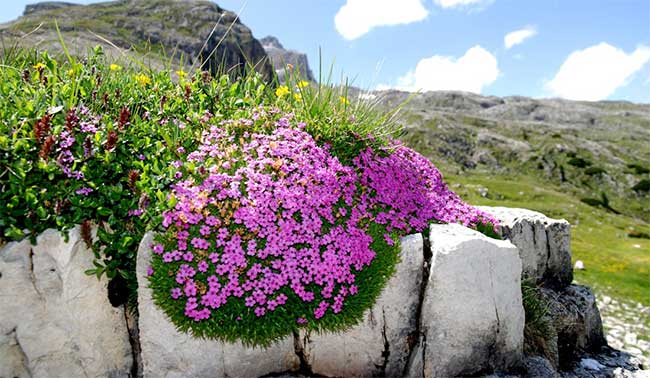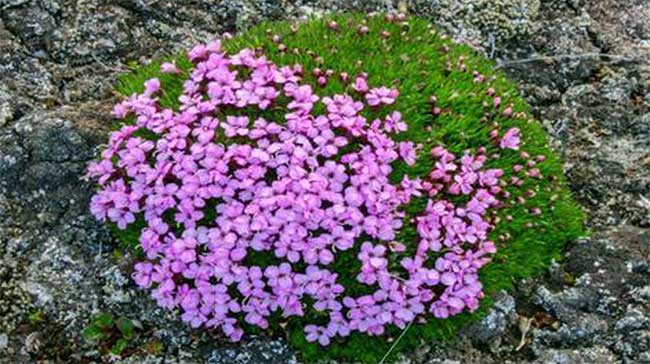The compass flower, scientifically known as Silene acaulis. This unique plant can live for up to 300 years in the frigid Arctic and blooms vibrantly under harsh conditions.
For nearly six months, the Svalbard archipelago remains in darkness due to the tilt of the Earth. During this time, the entire icy realm exists silently under the dominion of darkness. However, when spring returns, sunlight floods across the archipelago. By mid-summer, the archipelago enters a phase where the sun continuously hovers above the horizon.
Due to the extreme seasonal changes in the polar regions, survival is not an easy feat. Nevertheless, a species of compass flower known scientifically as “Silene acaulis” has found a way to endure.

The shape and structure of the plant is an effective solution for this species to withstand deadly winds.
As an expert on alpine plants who has spent considerable time studying the compass flower, Norwegian scientist Pernille Bronken Eidesen explains, the shape and structure of the plant is an effective strategy for coping with deadly winds, extreme cold, and nutrient scarcity in the polar regions.
Ms. Pernille states, “They grow in dense domes to retain heat.” On sunny days, even when outdoor temperatures are just above freezing, the temperature inside the centers of these plant clusters can reach up to 30 degrees Celsius.
The growth form of the compass flower not only helps increase internal temperatures but also extends the duration of blooming. In the polar regions, where factors contributing to pollen dispersal are extremely rare, extending the blooming period is crucial.
As the sun travels along the horizon, the intensity of sunlight changes. This leads to uneven heating of the compass flower’s dome. “The accumulated heat is higher on the south-facing side of the dome than on the north side, so although each flower only blooms for a week, the entire plant can bloom for a month.”
Due to its south-to-north flowering characteristic, the compass flower caught the attention of ancient explorers. They used the compass flower to navigate directions, which is why it is known as the compass flower.
In addition to these functions, the dome structure of the compass flower also helps the plant address the issue of nutrient deficiency in the polar regions. “This growth form ensures that the plant retains dead leaves inside the dome, allowing it to effectively fertilize the soil below,” reveals Ms. Pernille.

Compass flowers can live up to 300 years.
In the polar regions, longevity is a common trait among plants because “the growing season here is extremely short and unpredictable.” Some compass flowers can live for up to 300 years. This means that some compass flowers growing in Svalbard today are just slightly beyond their seedling stage, dating back to the time when England was still under the reign of King George II in the early 18th century.
According to Bronken Eidesen, to maintain their population, each compass flower only needs to replace itself. Thus, in its lifetime, the compass flower only needs to produce one viable seed to continue its lineage; that flower “has completed its mission.”
When the flowers wither, the trapped heat inside the dome protects the development of the seeds. However, as the plant’s stem ages, the fate of the seeds lies in the hands of Arctic gales.
Once released from their capsules, the seeds of the compass flower will embark on a journey into the wilds of the Arctic. In a world where a single flower can take three centuries to produce “an heir,” resilience is the compass flower’s secret weapon.


















































